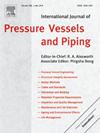内压和热载荷联合作用下加固软管的力学特性
IF 3
2区 工程技术
Q2 ENGINEERING, MECHANICAL
International Journal of Pressure Vessels and Piping
Pub Date : 2025-02-12
DOI:10.1016/j.ijpvp.2025.105458
引用次数: 0
摘要
增强聚四氟乙烯(PTFE)软管在运行过程中承受高内压和热负荷。这些条件对飞机管道系统的结构可靠性和安全性提出了重大挑战。为了研究内压和热载荷作用下加筋软管的力学特性,建立了高精度有限元模型。首先,研究了编织角和径厚比对加固软管承载能力的影响。随后,结合热负荷分析了不同环境温度下的力学响应。最后,通过21 MPa的耐压试验验证了仿真模型和方法的准确性。结果表明,54.7°为加固软管的最佳编织角,较小的径厚比可提高加固软管的耐压性能。金属增强层作为主要结构支撑,随着油压从10.5 MPa增加到21 MPa,金属增强层的应力增加了109.76%。此外,高温会导致金属增强层的应力集中,而极端的温差会导致内胎的严重变形。实验验证表明,有限元模型的最大应力误差在12.22%以内。这些发现为增强软管的设计和优化提供了重要的见解,强调了材料性能和结构配置如何提高复杂飞行条件下飞机管道系统的安全性和可靠性。本文章由计算机程序翻译,如有差异,请以英文原文为准。
Mechanical characteristics of reinforced soft tubes under combined internal pressure and thermal loads
Reinforced polytetrafluoroethylene (PTFE) soft tubes are subjected to high internal pressure and thermal loads during operation. These conditions pose significant challenges to their structural reliability and the safety of aircraft piping systems. To investigate the mechanical characteristics of the reinforced soft tubes under internal pressure and thermal loads, a high-precision finite element model is developed. Firstly, the effects of braiding angle and diameter-to-thickness ratio on the load-bearing capacity of the reinforced soft tubes are examined. Subsequently, the mechanical responses under varying ambient temperatures are analyzed in conjunction with thermal loads. Finally, the accuracy of the simulation model and methodology is validated through a pressure resistance test at 21 MPa. The results indicate that 54.7°is the optimal braiding angle for the reinforced soft tubes, and a smaller diameter-to-thickness ratio enhances the pressure resistance of the tubes. The metal-reinforced layer serves as the primary structural support, with its stress increasing by 109.76% as oil pressure rises from 10.5 MPa to 21 MPa. Additionally, high temperatures induce stress concentration in the metal-reinforced layer, while extreme temperature differences result in severe deformation of the inner tube. Experimental validation demonstrates that the maximum stress error of the finite element model is within 12.22%. These findings provide crucial insights into the design and optimization of the reinforced soft tubes, emphasizing how material properties and structural configurations can improve the safety and reliability of aircraft piping systems under complex flight conditions.
求助全文
通过发布文献求助,成功后即可免费获取论文全文。
去求助
来源期刊
CiteScore
5.30
自引率
13.30%
发文量
208
审稿时长
17 months
期刊介绍:
Pressure vessel engineering technology is of importance in many branches of industry. This journal publishes the latest research results and related information on all its associated aspects, with particular emphasis on the structural integrity assessment, maintenance and life extension of pressurised process engineering plants.
The anticipated coverage of the International Journal of Pressure Vessels and Piping ranges from simple mass-produced pressure vessels to large custom-built vessels and tanks. Pressure vessels technology is a developing field, and contributions on the following topics will therefore be welcome:
• Pressure vessel engineering
• Structural integrity assessment
• Design methods
• Codes and standards
• Fabrication and welding
• Materials properties requirements
• Inspection and quality management
• Maintenance and life extension
• Ageing and environmental effects
• Life management
Of particular importance are papers covering aspects of significant practical application which could lead to major improvements in economy, reliability and useful life. While most accepted papers represent the results of original applied research, critical reviews of topical interest by world-leading experts will also appear from time to time.
International Journal of Pressure Vessels and Piping is indispensable reading for engineering professionals involved in the energy, petrochemicals, process plant, transport, aerospace and related industries; for manufacturers of pressure vessels and ancillary equipment; and for academics pursuing research in these areas.

 求助内容:
求助内容: 应助结果提醒方式:
应助结果提醒方式:


